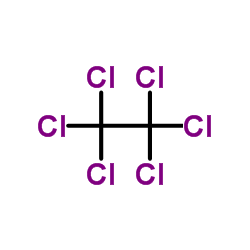Hexachloroethane

Hexachloroethane structure
|
Common Name | Hexachloroethane | ||
|---|---|---|---|---|
| CAS Number | 67-72-1 | Molecular Weight | 236.739 | |
| Density | 1.8±0.1 g/cm3 | Boiling Point | 186.8±0.0 °C at 760 mmHg | |
| Molecular Formula | C2Cl6 | Melting Point | 184 °C | |
| MSDS | Chinese USA | Flash Point | 61.3±15.8 °C | |
| Symbol |



GHS07, GHS08, GHS09 |
Signal Word | Warning | |
|
Development of QSAR models for predicting hepatocarcinogenic toxicity of chemicals.
Eur. J. Med. Chem. 44 , 3658-64, (2009) A dataset comprising 55 chemicals with hepatocarcinogenic potency indices was collected from the Carcinogenic Potency Database with the aim of developing QSAR models enabling prediction of the above unwanted property for New Chemical Entities. The dataset was... |
|
|
Optimizations of packed sorbent and inlet temperature for large volume-direct aqueous injection-gas chromatography to determine high boiling volatile organic compounds in water.
J. Chromatogr. A. 1356 , 221-9, (2014) For the expanded application area, fast trace analysis of certain high boiling point (i.e., 150-250 °C) volatile organic compounds (HVOCs) in water, a large volume-direct aqueous injection-gas chromatography (LV-DAI-GC) method was optimized for the following ... |
|
|
Carbon and chlorine isotope effects during abiotic reductive dechlorination of polychlorinated ethanes.
Environ. Sci. Technol. 41(13) , 4662-8, (2007) We investigated the extent and variability of C and Cl isotope fractionation during the reduction of polychlorinated ethanes to evaluate the potential use of Cl isotope analysis for the assessment of contaminant transformation in subsurface environments. Kine... |
|
|
Chemical-induced atrial thrombosis in NTP rodent studies.
Toxicol. Pathol. 33(5) , 517-32, (2005) Cardiac thrombosis, one of the causes of sudden death throughout the world, plays a principal role in several cardiovascular diseases, such as myocardial infarction and stroke in humans. Data from studies of induction of chemical thrombosis in rodents help to... |
|
|
Air pollutants formed in thermal decomposition of folpet fungicide under oxidative conditions.
Environ. Sci. Technol. 45(2) , 554-60, (2011) This contribution studies the decomposition of folpet fungicide under oxidative conditions and compares the product species with those of captan fungicide, which is structurally related to folpet. Toxic products arising from folpet comprised carbon disulfide ... |
|
|
Case report: hexachloroethane smoke inhalation: a rare cause of severe hepatic injuries.
Environ. Health Perspect. 114(5) , 763-5, (2006) We report on two patients, a 23-year-old man and a 24-year-old man, who had chemical pneumonitis and respiratory distress after inhaling hexachloroethane/zinc oxide (HC/ZnO) smoke during military training.The patients had been healthy previously and denied an... |
|
|
Pneumomediastinum associated with inhalation of white smoke.
Mil. Med. 164(10) , 751-2, (1999) Hexachloroethane (HC) smoke, also known as white smoke, is an obscurant used in numerous military situations. Many adverse health effects are associated with the use of white smoke, some of which are potentially life threatening. Inhalation is the most freque... |
|
|
Comparison of an assay forDehalococcoidesDNA and a microcosm study in predicting reductive dechlorination of chlorinated ethenes in the field
Environ. Pollut. 157(3) , 809-15, (2009) The study aims to compare the detection of 16S rRNA gene of Dehalococcoides species and the microcosm study for biotransformation in predicting reductive dechlorination of chlorinated ethenes in ground water at hazardous waste sites. A total of 72 ground wate... |
|
|
In vivo and in vitro evaluation of the acute toxicity, the genotoxicity, and the irritation potency of two hexachloroethane-based pyrotechnic smokes.
J. Toxicol. Environ. Health A 70(14) , 1167-81, (2007) The two hexachloroethane (HC)-based smoke formulations studied consisted of HC/Zn/2,4,6-trinitrotoluene (TNT) and HC/Zn. In the in vitro tests, human bronchial epithelial cells were exposed to the smokes at various concentrations. The responses studied were a... |
|
|
The phytotoxic effect of C(1)/C(2)-halocarbons and trichloroacetic acid on the steppe plant Artemisia lerchiana.
Chemosphere 65(6) , 975-80, (2006) Artemisia lerchiana is a wormwood species of the Central Asian steppe regions, where it completely cover whole areas. For the first time it was possible to show through field experiments that C(1)/C(2) halocarbons (VCHCs), such as chloroform (CHL), tetrachlor... |